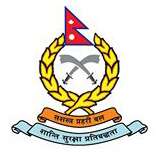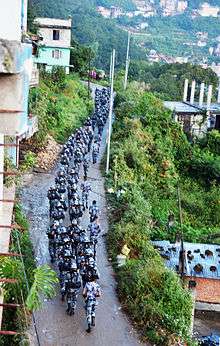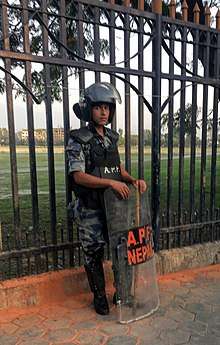Armed Police Force (Nepal)
| Armed Police Force | |
|---|---|
 Logo of the Armed Police Force | |
| Abbreviation | APF |
| Motto | Peace, Security and Dedication |
| Agency overview | |
| Formed | 2001 |
| Jurisdictional structure | |
| Federal agency | Ne |
| Operations jurisdiction | Ne |
| Governing body | Ministry of Home Affairs (Nepal) |
| Constituting instrument |
|
| General nature | • Federal law enforcement |
| Headquarters | Kathmandu, Nepal |
|
| |
| Minister responsible |
|
| Agency executive |
|
| Child agency | |
| Website | |
|
www | |


The Armed Police Force of Nepal is a paramilitary Land warfare force tasked with counter-insurgency operations in Nepal. It functions as a semi-military wing, and occupies a sort of dual role as both military and law enforcement. Service is voluntary and the minimum age for enlistment is 18 years. Initially founded with a roster of 15,000 police and military personnel, the Armed Police Force is projected to have a corps of 40,000 at the close of 2015.
In February 1996, the ideologically Maoist Communist Party of Nepal operating as the United People's Front of Nepal initiated what was then dubbed the "People's War". Ensuing armed resistance and criminal activity escalating from the conflict motivated King Gyanendra to consider amassing an independent police force. Subsequently, the Armed Police Force was founded on 24 October 2001. Late Krishna Mohan Shrestha of the Nepal Police (then serving as Additional Inspector General of Police) was its first Chief.
The current command and control organization of Nepal's army is outlined along the protocol of the 1990 Constitution and its interim constitution. Its standing Inspector General is the Chief of Armed Police Forces, equivalent in rank to a three star Lieutenant General of the Nepal Army.
The fundamental ethos of the Armed Police Force (APF) is Peace, Security, Commitment.
Combat Brigades
The Armed Police Force is a paramilitary force organized as combat brigades. Each combat brigade is responsible for one of the five regions and Kathmandu Valley in the country. APF for its origin and given mandated tasks is a dynamic organization in a sense that multi facet jobs resembling to military and police are embodied into one.
A combat brigade is commanded by a Deputy Inspector General (DIG) and comprises infantry battalions and independent infantry companies. Depending upon the geographical region of the country each combat brigade may have two to three infantry battalions and up to four or more independent infantry companies.
Senior Superintendents are the regional level commanders for training colleges located at five regions with status of principal.
An infantry battalion commanded by a Superintendent (SP) comprises rifle companies, support company and an administrative company. Deputy Superintendents (DSP) command the companies and the Inspectors command platoons. Sub Inspectors are the platoon second in command. A platoon consists of three sections and a Senior Head Constable (SHC) commands each section.
Combat Support Brigade
The brigadier generals command all the support brigades. Each brigade is responsible for the training, posting and promotion of the other ranks. Each brigade commander is also responsible to advise the IG on matters pertaining to his respective brigade and region.
History
The Armed Police Force was founded in 2001 to help Nepal's army and civil police force counter a growing Maoist insurgency in Nepal. It was fundamentally a paramilitary organization and mostly engaged in counterinsurgency operations. In August 2003, five constables of the Armed Police Force were killed in a military operation in the Ramechapp District of Nepal which killed 39 Maoist rebels.[1] In January 2003, the head of the Armed Police Force Inspector General Krishna Mohan Shrestha was shot and killed by Maoist insurgents while taking his morning walk, alongside his bodyguard and wife who were also killed.[2][3]
Weaponry
Major functions of Armed Police Force
- To control an armed struggle occurred or likely to occur in any part of Nepal.
- To control armed rebellion or separatist activities likely to occurred in any part of Nepal.
- To control terrorist activities occurred or likely to occur in any part of Nepal.
- To control riots or likely to occur in any part of Nepal.
- To render assistance to the relief of natural calamities or epidemic occurred or likely to occur in any part of Nepal.
- To carry relief operation in a case where a citizen of Nepal or any person is abducted and to control heinous or serious crime if such crimes re committed or a disorder of serious nature has occurred or likely to occur in Nepal.
- To maintain border security.
- To provide assistance to Nepalese Army in case of external intervention.
- To provide building security and security if vital utilities and other places of public importance as prescribed by Government of Nepal.
- To provide security to person and prescribed institutions as prescribed by Government of Nepal.
- To carry out other functions as referred to and in this Act,Rules framed here under or as prescribed by other prevailing laws.
- To carry out other functions as prescribed by Government of Nepal from time to time.
Current Department and Commandar
| S.N. | Department | Commander | |||
|---|---|---|---|---|---|
| 1 | National APF Academy | AIG Ram Saran Poudel | 2 | APF Human Resource Development | AIG Shailendra Khanal |
| 3 | APF Operation | AIG Puspa Ram KC | |||
| 4 | APF Administration | ||||
| 5 | APF Border Security | ||||
| 6 | Metropolitan APF Security Office | APF AIG Narayan Babu Thapa |
Operations
In November 2001, the Nepalese armed forces began military operations against the Communist Party of Nepal (Maoist). And Armed Police Force has involved in this operations with the birth of is organization alongside with Nepal Army.
Allegations of war crimes and human rights abuses have been leveled by the media against members of the Armed Police Force.
See article Nepalese Civil War
International Peace Keeping Missions
Armed Police Force takes pride in contributing its soldiers in peacekeeping efforts under the coveted blue flag of the United Nations for global peace and security as a whole. Armed Police force involved UN Peace keepings missions are now 32 and more than 2000 armed police force personal has contribute on the mission.
Also the APF has its remarkable contributions with advisers, trainers, monitors and in contingents of FPUs in missions like Iraq (UNGCI), Kosovo (UNMIK), Liberia (UNMIL), Sierra Leone (UNAMSIL), Haiti (MINISTAH), Sudan (UNMIS) and South Sudan (UNMISS). APF has two Formed APF Units each of 120 personnel in Liberia (UNMIL) since December 2003.
See also
References
- ↑ Nepalese Rebels Walk Away from Peace Talks http://www.worldpress.org/Asia/1478.cfm
- ↑ New York Times: Nepal's Police Chief Killed https://www.nytimes.com/2003/01/26/world/nepal-s-police-chief-killed.html
- ↑ NEPAL: HEAD OF ARMED POLICE FORCE ASSASSINATED IN KATHMANDU https://wikileaks.org/plusd/cables/03KATHMANDU140_a.html
- ↑ http://news.bbc.co.uk/media/images/36455000/jpg/_36455819_policeap300.jpg
- ↑ https://pbs.twimg.com/media/CF69sbpUoAAgq7c.jpg
- ↑ http://image.ohmynews.com/down/images/1/todd_269203_1[409796].jpg
- ↑ http://media.gettyimages.com/photos/nepals-armed-police-forces-march-during-the-9th-republic-day-parade-picture-id534801158
- ↑ http://www.nepaldispatch.com/wp-content/uploads/2013/05/armed_police_force_nepal.jpg
This article contains material from the official website of Armed Police Force of Nepal